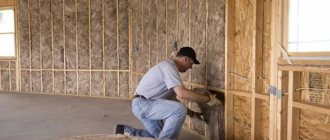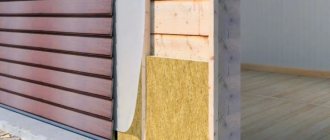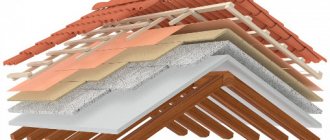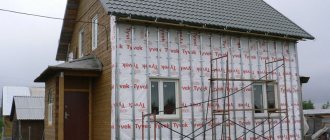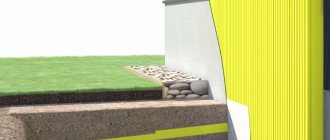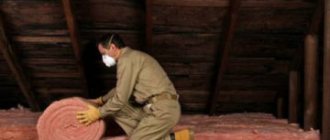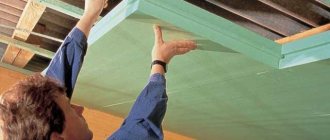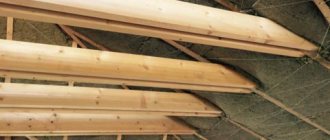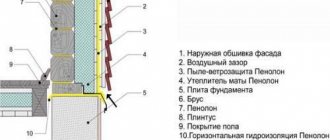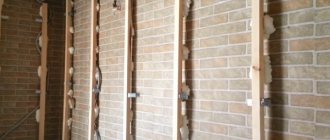Usually a house is built quickly, often everything is put under the roof during the summer season. After interior decoration, you can move in, improve the local area and expand the functionality of the house. In this article we will tell you how to insulate an attic from the inside if the roof is already covered. The information will help you decide on the choice of material - this often depends on the initial conditions, and will explain the subtleties of its correct use.
Insulation of an already covered roof has its own characteristics that you need to know about Source pinterest.com
After this, you will speak the same language with the builders. Which is a good incentive for them to offer and demonstrate their best and do the work even better.
General points
Let's start with the fact that the attic is a bit of a special room. Its overall structure requires a careful, meticulous approach. And the insulation of the attic roof is even more so:
- Mostly vertical or inclined surfaces . Therefore, it is better to immediately exclude all soft “pliable” materials, namely mineral wool rolls.
- It is advisable to focus on materials with low dead weight . Since the rafter system is already experiencing significant loads from wind and snow. In addition, the load on load-bearing walls will not increase much.
- Often insulation is required for gables . They are not always made by analogy with a main wall. May be made of facing material. Or the frame is simply built for insulation.
- It happens that the area of the attic significantly exceeds the size of the house itself , while part of it rests on columns. In this case, you will also have to insulate the ceiling in contact with the street.
If the attic floor protrudes beyond the house, additional insulation of the floor is required. Source metasold.com
It should be understood that the thickness of the insulation must correspond to the weather conditions of a particular climate zone, while having a small margin. To gain the required thickness, the insulation is installed in several layers, and the relatively small dimensions require joining.
Important: splicing any insulation requires a careful approach. The joints of different layers should not be concentrated in one place. To prevent freezing, they should be spaced as far apart as possible. It is important to constantly remember this so as not to spoil the material, especially when insulating a sloping roof.
What material to use for thermal insulation
Before you insulate the attic, you need to decide on the choice of the heat-insulating material itself.
That is, it is important not only how to insulate the attic for winter living, but what exactly is the best way to carry out such work. In addition, the range of products is now huge. But objectively, mineral wool and glass wool remain the most popular. In the case of an attic, they are used more often than others.
Although you shouldn’t forget about other insulation materials for frame houses and other structures.
Based on experience and practice, mineral wool and glass wool will ultimately still be a priority for this particular case.
Fiberglass is inexpensive, does not burn, and does not contain organic or harmful substances. When tightly attached to the base, it provides excellent thermal protection. But such an effect is achieved only subject to strict adherence to technology.
At the same time, glass wool has its disadvantages. One of them is microfibers, which can get on the skin and also penetrate the respiratory tract. It is very dangerous. Therefore, you need to work in a respirator and protection. Glass wool is also inconvenient for insulating inclined surfaces. Over time, the tight fit disappears, which negatively affects the quality of insulation.
Basalt wool is in many ways superior to glass wool. It is lightweight, harmless, and also has good soundproofing characteristics. Easily attaches to inclined surfaces. However, the price is slightly higher. For inclined walls, take slabs, and for horizontal surfaces, rolled mineral wool is perfect.
It’s better not to save money, but immediately take a more efficient and easy-to-use heat insulator.
Preparation
All wooden surfaces must be treated with antiseptic and fireproof impregnations.
All wooden components must be treated with protective materials Source remontik.org
It is necessary to immediately identify “unreliable places” on structural elements. For example, the connection of the outer rafter to a pediment made of facing bricks. Or an overlapping connection between a rafter and a screed, made without insulation. It is necessary to eliminate the shortcomings - if possible, foam them or line them with a sealant. Otherwise, they will not be able to withstand through blowing and freezing.
It is necessary to minimize the use of metal fasteners. This is especially true for metal linings secured with bolts. Of course, the bolted connections will remain, but the plates should be made from thick, durable plywood and replaced. The remaining metal parts are painted with primer-enamel and covered with a layer of polyurethane foam. Metal directly in the insulation is a source of condensation and dampness.
Insulation of the rafter system
It’s great when the insulation of the attic from the inside was planned in advance, or “just in case” the constructive points for this were observed by the builders:
- A roofing membrane is mounted on the rafters.
- A counter-lattice is provided.
- The pitch of the rafters is maintained corresponding to the common length or width of the insulation.
It is convenient to carry out insulation if it was planned at the construction stage Source bamban.ru
It is worth noting that these are ideal initial data that allow you not to look for a “way out of the situation” and to insulate the maximum volume of the attic efficiently without extra costs. Such conditions make it possible to use vapor-permeable insulation. And these are comfortable living conditions.
See also: Catalog of projects of houses with an attic presented at the exhibition “Low-Rise Country”.
Insulation of an unprepared roof
When the decision to insulate is forced, the roof is usually not prepared. There is nothing terrible about this, it is even possible to choose the following options:
- Insulate with materials that do not require waterproofing.
- Build a special frame for living space.
In case of insulation of a roof that is not prepared for this, special compounds can help Source paspraypros.com
Foamed polyurethane foam can play a special role here. Although equipment is required to apply it, insulation occurs in a continuous layer and does not depend on the design features of the roof.
Foamed polyurethane foam is one of them Source da.decorexpro.com
This also includes ecowool. Although its installation requires a roofing membrane, it is quite possible to make a continuous layer of insulation.
Waterproofing installation process
Ideally, waterproofing is installed as follows:
- material wraps the rafters;
- laid close to the insulation.
Waterproofing is often rolled out over the rafters to save money, not stretching, but creating a sag of several centimeters. This option can also be considered good, since moisture falls on the surface, after which it rolls down and leaves the roof. Another important point is the exit of the membrane into the drainage gutter. Due to this, moisture will move out from the under-roof space.
A number of aspects of membrane installation can be highlighted. It is laid across the rafters starting from the bottom. The first option is launched into the gutter. The next layer is rolled out to the ridge. On the membrane ridge, the material is pulled on both sides along the upper edge, after which it is fixed. A strip is rolled out lengthwise along the ridge. It goes down from one and the other side of the roof. A coating is formed along which water can flow directly to the drainage gutter.
Effective insulation
Next, we will consider the most effective materials that do not require serious equipment in order to efficiently insulate the attic.
Stone wool
Due to their elasticity, the mats adhere well between the rafters and allow installation without additional fastening. And the relatively dense structure of stone wool prevents its shrinkage over time. Therefore, it has proven itself well on vertical surfaces.
Stone wool mats come in different thicknesses, and you can choose the one you need based on climatic conditions and other materials used Source pallazzo.su
To further reduce the risks, every 3 meters of height it is necessary to arrange supports for the insulation - add a horizontal frame element.
Such different cotton wool
Structurally, the material looks like cotton wool fibers, designed in the form of mats (plates) or rolls. Several types of mineral (construction) wool are produced, varying in raw materials and fiber parameters. The following varieties are distinguished:
- Glass wool. The raw material is molten glass.
- Basalt (stone). It is obtained from rocks of volcanic origin.
- Slag. From industrial waste (for example, from blast furnace slag).
Mineral wool in a roll Source alkiv.ua
To obtain cotton wool, the raw material is turned into a melt under the influence of high temperatures. The melt is then sent to a centrifuge, where a characteristic thread-like mass is formed. It turns out to be quite loose, with air cavities, the reason for its high heat-insulating properties.
Cotton wool consists of fibers up to 15 microns thick and up to 50 microns long. Blocks (or rolled material) of a certain density are formed from the fibrous mass, then treated with hot air. A small amount of synthetic resin helps bind the fibers together. Mineral wool is used everywhere for attic insulation due to the successful combination of the following qualities:
- Simplification of installation work. The fibers give the material elasticity, and the shape of the plates allows you to work without additional fasteners. For example, the cotton wool is simply cut to the size of the gap between the rafters (2-3 cm wider) and inserted into the intended place.
- Budget cost combined with environmental friendliness and non-flammability.
- Low thermal conductivity, which depends on the initial density. Thermal conductivity increases over time if moisture penetrates the material.
Basalt slabs - a convenient format for working on inclined planes Source vesta-teplij-pol.ru
- Additional advantages: the use of the material improves sound insulation, and it can easily withstand both high and low temperatures.
- Peculiarities. The thickness of mineral wool is chosen taking into account the characteristics of the region of use; the permissible thickness is specified in SNiP documents.
The highest quality insulation of an attic roof can be done using stone wool. It is more expensive than alternative options, but it allows you to create more durable protection that retains its properties for a long time. Polymer resins that make up stone wool become a source of toxic emissions only at the melting temperature (+700°C); in other words, under normal conditions it is a completely safe option.
Glass wool has its advantages: it is frost-resistant and retains its characteristics even with significant temperature fluctuations. Due to the nature of production, glass wool has longer, and therefore more brittle, fiber.
They try not to use glass wool in residential buildings Source made-in-china.com
Under mechanical stress, glass fibers break into small fragments. Debris causes irritation to the skin and mucous membranes, so work with the material only in thick clothing (including gloves, a respirator and goggles). Glass wool also needs careful waterproofing, as it absorbs moisture stronger than a mineral product.
Slag wool, the result of processing waste from metallurgical plants (blast furnace slag), is a non-combustible material, which, however, begins to melt at a temperature of 300°C. Its main advantage is low cost, and in terms of performance characteristics it is not much inferior to stone and mineral wool.
The share of binding resins ranges from 2 to 10% of the total mass of slag wool, and this is the main disadvantage of the material, raising questions from the point of view of environmental friendliness and the possibility of insulating the attic floor from the inside with its help. Blast furnace slags are highly acidic. The same property is observed in slag wool; contact with moisture leads to the formation of acid and destruction of metal elements (for example, hardware).
A respirator is a mandatory piece of equipment when working with glass wool Source lvdmbvba.be
See also: Catalog of companies that specialize in home insulation
Proper completion of work
The insulation has been installed, but the process must also be completed correctly. It must be protected from damp vapors from the room. For this, a vapor barrier film is installed. Moreover, the overall result greatly depends on the thoroughness of execution. Although each package is supplied with instructions, let us briefly repeat:
- The subsequent canvas overlaps the previous one by at least 15 cm.
- The joints are taped with special tape.
However, attic vapor barrier has a dual purpose. Oddly enough, it also protects the residents themselves. The fact is that vapor-permeable insulation is not strong enough and can be slightly weathered. From the outside this is not so important, plus it is protected by the roofing membrane. And inside it is necessary to exclude even the minimal possibility of the insulation components being released into the air - to reliably cover it.
The final stage is covering the insulation with canvases, on which the finishing is subsequently applied. Source obustroeno.com
Of course, this does not apply to Penoplex. But it is also recommended to protect against it; an effective material is penofol.
As for insulation of any type. In addition to the vapor barrier device, a technique that at first glance is unnecessary, but effective, is often used. Before finishing, intermediate, seemingly unnecessary material is installed. It can be OSB, GVL or GKL - it depends on the design. Moreover, the technology is fully observed - all joints are carefully sealed. This is an additional barrier against the unwanted effects of materials.
Basic mistakes
All the positive aspects of insulation can be negated by errors in their installation:
- Carrying out work at low temperatures. This leads to insufficient drying of the glue and loss of strength of the insulating layer.
- Wrong choice of material thickness. Insulation of insufficient thickness will not give the desired effect, and a layer that is too thick will lead to unnecessary material costs.
- Sliding of thermal insulation due to insufficient fastening. This leads to the appearance of unprotected places and intense penetration of cold through them.
- Lack of vapor and waterproofing. In this case, the insulation will get wet, absorbing moisture, and will quickly lose its properties.
- Installation of steam and waterproofing films with sagging. These materials should be attached with slight tension.
- Lack of ventilation. In an unventilated attic, condensation forms on and inside the walls, damaging the insulation.
When carrying out work on thermal insulation of the attic yourself, it is necessary to take a responsible approach to all stages - from developing the project to attaching the final finish. In this case, a room created with your own hands will delight the owners with comfort for a long time.
